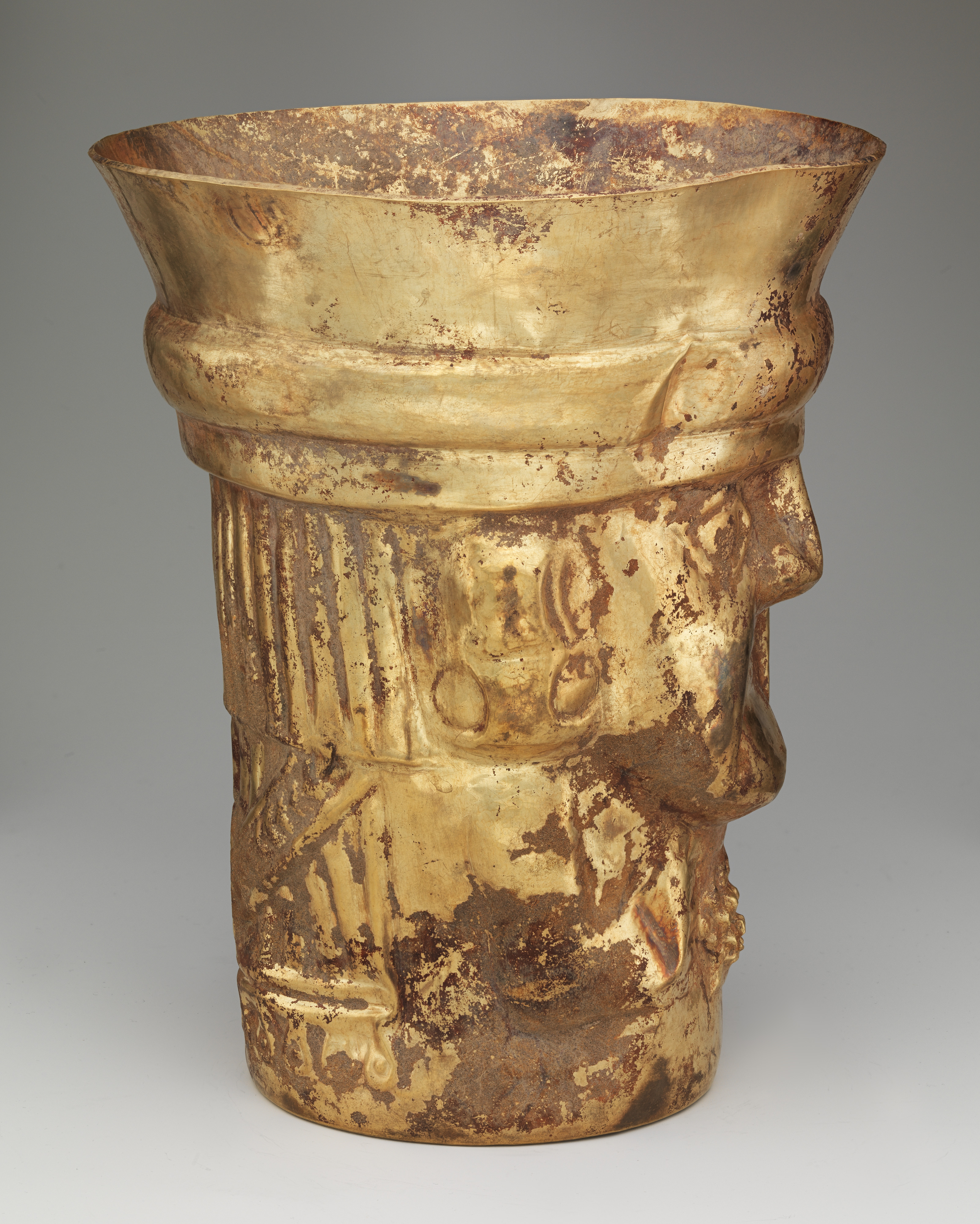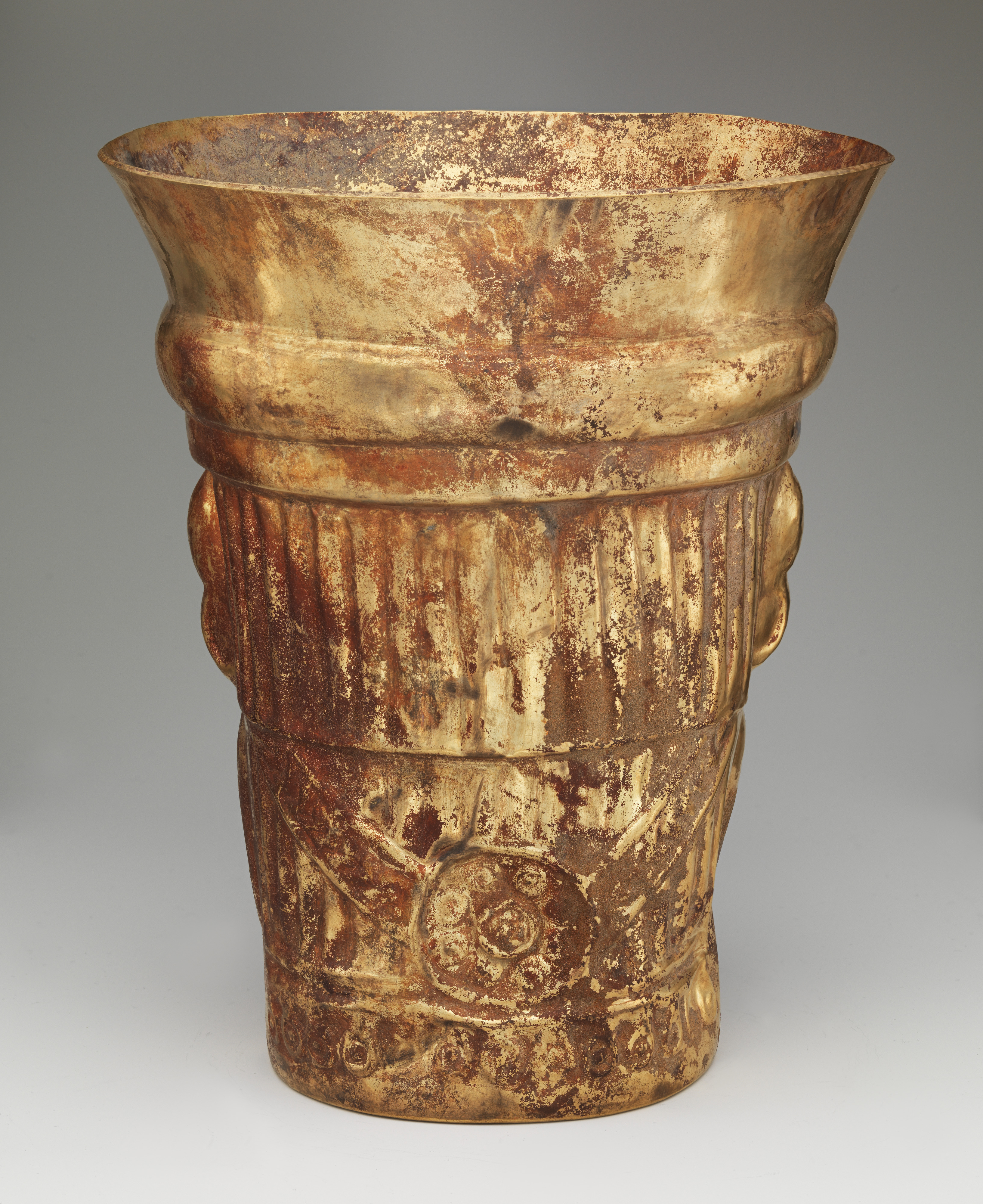Beaker with figure and Spondylus shell
Not on view
Gold beakers, both plain and ornamented with embossed designs, were markers of status and authority on Peru’s north coast in the centuries before the rise of the Inca Empire. This vessel was sculpted in the shape of the torso and head of an individual wearing a cap and holding a shell. One side of the beaker features the embossed face and hands, while the other side is rendered as the back of the individual’s head. The figure wears round ear ornaments, and the hair, on the back of the vessel, is rendered in two layers; the longer layer is decorated at the bottom with a row of disks. Two wide bands with a chevron pattern hang down from the cap over the hair, meeting in a central medallion of two concentric circles surrounded by seven smaller ones.
The shell depicted between the hands of the figure is most likely Spondylus, a bivalve found in the warm tropical waters north of the Santa Elena Peninsula in Ecuador. Often called the thorny oyster, the spiky shell was prized for its rich color (ranging from red to orange to purple) and used to create exquisite ornaments (see 2003.16). Spondylus was also closely associated with ideas of fertility and abundance: in the early colonial period the shells were called "daughters of the sea, mother of all waters." The shell is depicted on a number of highly similar beakers (see 1991.419.62), and may refer to the owner’s ability to secure the blessings of agricultural success for a broader community.
The Lambayeque (also known as Sicán) culture is named for a region on Peru’s north coast. One of the major Lambayeque sites, now known as Batán Grande in the Santuario Histórico Bosque de Pómac, thrived near the La Leche River from the ninth to the eleventh century. This period coincides with a sharp uptick in the importation of Spondylus into Peru, and the fortunes of Batán Grande may have been due, in part, to its control of this trade, as well as by their great industry and innovation in metal working. The city was dominated by a series of monumental platform mounds (huacas), some of which contained extraordinarily rich tombs, notable for the number, size, and quality of the objects found within them. A major tomb from Huaca Loro, one of the principal platform mounds at the site, included dozens of vessels, in addition to gold masks and other objects (see 1974.271.35 for a Lambayeque funerary mask).
Hammered sheet gold or silver was the preferred medium for objects in the highest-status tombs. The metal here, probably a naturally occurring high-karat gold, contains 74% gold, 24% silver, and 2% copper, by weight. It was fashioned by raising the basic form from a single piece of sheet metal. The relief designs were then added by working the metal using both a wooden form and resilient materials into which the metal could be pressed with a tracing tool. Batán Grande once supported large and sophisticated workshops capable of producing the vast numbers of objects presumably needed for the daily life of the royal court, and ultimately for entombment in the huacas. The reddish substance on the surface of the beaker is iron oxide-hydroxide deposited over centuries of burial.
Joanne Pillsbury, Andrall E. Pearson Curator, 2015
Further Reading
Carcedo, Paloma, "Los vasos en la orfebrería Sicán," in Cultura Sicán: Esplendor preincaico de la costa norte, edited by Izumi Shimada, translated by Gabriela Cervantes, pp. 107-146. Lima: Fondo Editorial del Congreso del Perú, 2014.
Jones, Julie, ed., The Art of Precolumbian Gold: The Jan Mitchell Collection. Boston: Little Brown, 1985.
King, Heidi, Rain of the Moon: Silver in Ancient Peru. With contributions by Luis Jaime Castillo Butters and Paloma Carcedo de Mufarech. New York: Metropolitan Museum of Art; New Haven: Yale University Press, 2000.
Mackey, Carol J. and Joanne Pillsbury, "Cosmology and Ritual on a Lambayeque Beaker," in Margaret Young-Sánchez, ed., Pre-Columbian Art & Archaeology: Essays in Honor of Frederick R. Mayer, pp. 115-141. Denver: Denver Art Museum, 2013.
Pillsbury, Joanne, "The Thorny Oyster and the Origins of Empire: Implications of Recently Uncovered Spondylus Imagery from Chan Chan, Peru." Latin American Antiquity 7, no. 4 (1996):313-340.
Rickenbach, Judith. Sican, ein Fürstengrab in Alt-Peru: eine Ausstellung in Zusammenarbeit mit dem peruanischen Kulturministerium. Exh. cat. Zurich: Museum Rietberg, 1997.
Shimada, Izumi. Cultura Sícan: Dios, riqueza y poder en la costa norte del Perú. Lima: Fundación del Banco Continental para el Fomento de la Educación y la Cultura, Edubanco, 1995.
Shimada, Izumi, Jo Ann Griffin. "Precious Metal Objects of the Middle Sican," Scientific American (April 2004), pp. 80-89.
Shimada, Izumi, Ken-ichi Shinoda, Julie Farnum, Robert S. Corruccini, Hirokatsu Watanabe. "An Integrated Analysis of Pre-Hispanic Mortuary Practices: A Middle Sican Case Study." Current Anthropology 45, no. 3 (2004), pp. 369-402.
Wester de la Torre, Carlos, Mystery and History in the Lambayeque Culture: The Priestess of Chornancap. Lambayeque: Museo Arqueológico Nacional Brüning, 2013.
Due to rights restrictions, this image cannot be enlarged, viewed at full screen, or downloaded.
This artwork is meant to be viewed from right to left. Scroll left to view more.




